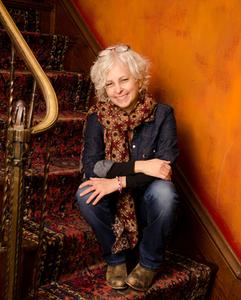 |
|
| (photo: Catherine Smith) | |
Kate DiCamillo, with almost 37 million books in print worldwide--including The Tale of Despereaux, Flora & Ulysses (both of which received Newbery Medals) and Because of Winn-Dixie (a Newbery Honor book)--is both prolific and beloved. She served as National Ambassador for Young People's Literature, appointed by the Library of Congress.
The first draft of The Beatryce Prophecy (Candlewick Press, September 28, 2021), an illustrated middle-grade novel about a medieval heroine's quest for truth, family and home, languished in DiCamillo's office closet for a decade. DiCamillo discovered it one day while cleaning and decided to resuscitate it. Countless readers may never know how close we came to not meeting the girl who wasn't supposed to read, the brave, visionary monk who cherished beauty and kindness above all else and the most aggressively loyal goat in the world. Thank goodness for housecleaning!
The Beatryce Prophecy opens with the fierce, intelligent, growling, biting goat, Answelica, who rapidly becomes one of the heroines of the story. Where, oh where did she come from (imagination-wise)?
I've gone back through all my old notebooks, searching for a good answer to this question... and guess what? I don't know. All I can tell you is that her name arrived first (I found the word "Answelica" written next to the word "monk" and the word "moon" in a notebook). I followed the name and found a goat. It's not unusual for me to start a story with just a name; it is unusual for such a ferocious, funny, hard-headed, loving creature to spring forth from so few letters. It's one of the joys of writing, when the character shows up like that.
In Beatryce's world, writing and reading are forbidden for everyone but monks and kings and counselors. Why is writing still so powerful, so potentially dangerous?
I struggled a little bit, learning to read. And when that door finally opened to me, I remember being dazzled by the light, and thinking, "Nothing, nothing can stop me now."
The written word empowers the individual.
The brothers of the Order of the Chronicles of Sorrowing are a gloomy lot, penning "beheadings and treachery and war and prophecies of doom and suffering." But they also see and create beauty when they illuminate the letters in the Chronicles or when they make maple candies in the shape of flowers and birds. How is your work like the work of these monks?
Oh, I love this question. Because that's it, isn't it? That's the whole challenge of storytelling: to tell the truth about the world, to capture its beauties and its terrors, to make something light (illuminated letters) and sweet (maple candies) even in the darkness.
What (if any) role does feminism play in The Beatryce Prophecy?
I write, as a writing teacher once told me, behind my own back. Which is to say that feminism does play a role (a big role) in this story, but I did not sit down intending to write a feminist tale. I worked to tell a story about friendship and the redeeming power of love and stories. It was only after I was done and other people started to read and comment on the story that I could see the feminist themes--the empowerment that happens when we are encouraged to find out exactly who we can be in the world, without other people telling us that we can't, we won't, we shouldn't.
The setting in The Beatryce Prophecy is so evocative. Were you picturing any one place in today's world?
Writing the book for me was so often like trying to remember a dream. I didn't have any particular place in mind, I was just trying to capture the light and contours of that dream.
Beatryce is on a heroine's journey, but her companions Jack Dory, Cannoc, Brother Edik and perhaps even the goat Answelica, have their own Odyssean quests along the way. Did you mean to do that all along or did they demand it of you?
I mean to do nothing all along. Which is to say that I, the teller of the tale, don't know what's going on. All I know is that I, too, am on a journey. And I feel lucky that I got to journey with these characters.
Do you believe that we must act to make our fate come true, as the false king claimed?
I think that maybe the most important thing we can do to become ourselves, to make our fate come true, is to pay attention--to other hearts, to our own hearts.
Do you have a favorite Sophie Blackall illustration in the book?
Sophie's art is miraculous. I love all of it. But there is a two-page spread showing Beatryce being spirited away by the king's men while above her a story unfolds in the sky--that piece of art makes my heart skip a beat every time I see it.
Did this pandemic year change your writing routine or what or how you write?
I wrote more during the pandemic. I was home more and that gave me the chance to write. And I felt grateful for the calming, centering process of telling a story.
What are you working on now?
I've been having a good time telling fairy tales recently.
Anything else you'd like to tell the readers of Shelf Awareness?
Yes: Thank you. Thank you to everyone who reads books, everyone who reads a story aloud to someone, everyone who puts a book in someone else's hands. --Emilie Coulter

